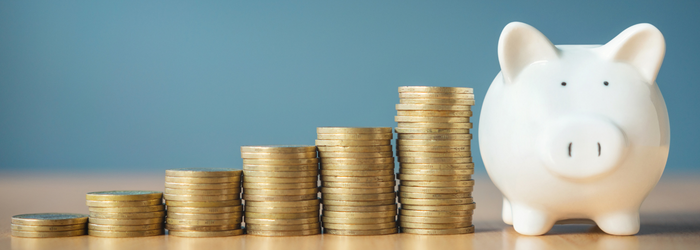Wallet-Friendly Tips for Reducing Waste
As the cost-of-living continues to increase, many of us are changing the way we shop, consume and spend. Here are some reduce, reuse and recycling tips that will make a difference and save you money!

Bottled water
Although most Australians are able to access extremely good, safe drinking water straight from the tap and there was no public health or water quality advantage in drinking bottled water, we’re spending an average of $580 a year on bottled water, making us the second-biggest consumer globally. You can save all that money by remembering your reusable bottle and drinking tap water or filling up at public drinking water fountains.
Minimising food waste
Reducing food waste is one really simple and effective way to help the average household save thousands of dollars each year. You can help reduce food waste by meal planning, using leftovers and composting rather than putting scraps in landfill. Empty plastic containers with lids, such as ice-cream tubs, are perfect for collecting food waste in your kitchen. Keep one under the sink and pop the lid on tightly so there’s no smell. Food waste can be used in your garden to revitalise the soil in a number of ways - either in a compost bin, worm farm or simply burying it 15-20 cm deep straight in the ground.
If you don’t have a garden, consider asking your local community garden if they accept food waste in their compost bins or connect with your neighbours who are already composting via ShareWaste.
If you’d like to start composting but are concerned by the cost or unsure about where to start, check out Compost Community, a government-funded organisation aiming to make composting accessible and affordable, or your local council websites for compost system rebates.
Leftovers Stock
Instead of tossing veg scraps and leftover bones, use them to make a homemade stock! Save those old-but-not-quite-off veg and any offcuts from carrots, onions, garlic, leeks, celery, turnips, ginger, tomatoes, mushrooms and fennel and keep them in the freezer.
To make a veggie stock, thaw the scraps in a pot and then cover with water and simmer for 10 minutes before straining (any longer results in an overwhelmingly sweet flavour as freezing the vegetables changes how they cook). For a chicken or beef stock, simmer the cooked or uncooked bones in water for 3 hours and then add the thawed scraps for the last 15 minutes of cooking.
Not only is it a delicious alternative to store-bought stock but it’s a great way to get the most out of your groceries and reduce the amount of old produce we throw away!
Ugly food
Between 20%-40% of all fresh produce in Australia is thrown away each year before it even leaves the farm for looking ‘imperfect’, despite tasting exactly the same as their prettier counterparts. Some retailers and delivery box services are committed to reducing food waste by selling these ‘ugly’ fruit and veg for up to 50% less. Buying this produce supports farmers, reduces the amount of resources being used on food that is wasted, and saves money on your grocery bill.
Regrowing from kitchen scraps
Did you know you can regrow spring onions in a container of water at home? These tasty greens are one of the easiest things to grow. All you need to do is fill a container with a little bit of water (old jars are great for this) and add the root end of the onions. As they acclimatise, some of the ends will turn yellow - just snip them off with a pair of scissors. When you’re whipping up your next stir-fry, simply chop off the needed amount of the green tops and pop the roots back in the water. You will need to change the water every few days or when it starts to smell onion-y.
Other vegetables you can grow in water from the leftover ends include celery, lettuce, bok choy, cabbage and wombok by piercing 3 or 4 toothpicks in the sides and balancing on a jar, so the bottoms are just touching the water.
Bringing your own coffee cup
One billion single-use takeaway coffee cups are thrown away by Australians every year. Bringing your own cup can significantly reduce this number and is encouraged by many cafes around the country through BYO cup discounts. Using websites like Responsible Cafes you can find out which cafes near you offer reduced prices for bringing reusable cups or have implemented a cup library system in case you forget yours at home! It also has some great features to find out which cafes are plastic-free and compost-friendly.
Shop pre-loved
As tempting as it is to buy cheap clothing that is produced rapidly by mass-market retailers, it’s important to remember Australia the second highest consumer of textiles per person in the world, after the USA. It is estimated that the average person buys 60% more clothing and keeps them for about half as long as 15 years ago, with each of us disposing an average 23 kilograms of clothing to landfill each year. To save money on your wardrobe shop at your local charity stores or seek out specialised retailers that sell only high quality, pre-loved fashion.
Discover the world of fashion rentals
If you have a special occasion coming up and need a one time only piece to wear why not rent an outfit instead of buying something new? Or round up your mates for a clothes swap?
Reducing and reusing paper
Changing the way you receive your bills from snail mail to online is a great way to reduce paper usage for free at home - but sometimes you just can’t help using paper, particularly at work or school. Give your garden a carbon boost by shredding or tearing your paper scraps and adding them to compost, using as mulch, or lining the bottom of a raised garden bed. If you don’t have a garden, your paper can have a second life before hitting the recycling bin as note-taking pads by tearing A4 sheets in half and clipping them together with a bulldog or paper clip.
Milk cartons or plastic bottles as garden pots
Reduce the need to buy plastic nursery pots by reusing milk cartons and plastic bottles to grow leafy greens such as lettuce, spinach, bok choy or herbs. Simply cut the bottles in half, poke some holes at the base or lid end as drainage holes (using a nail heated over a candle is an easy way to do this but be sure to wear gloves) then fill them with soil and plant your seeds! The bases of the bottles will be able to stand on their own but the top halves will need to be hung using some twine. Most leafy greens can regrow once you’ve harvested them if you cut 2-3 cm above the base of the plant, saving you from having to continue buying them!
Food containers
The best way to reduce waste is to simply eliminate acquiring waste in the first place, however we all know that’s not viable 100% of the time. So during those times where you’re craving the warm comfort of a takeaway curry, consider saving the plastic container it comes in as a free alternative to lunch boxes and cling film for storing your food, or even as a budget drawer organisers so you don’t have to keep losing your keys or that lip balm that’s always sneaking away. Empty tic tac containers are also a great way to store small items that often go missing like hair ties, safety pins, and bobby pins so you don’t have to keep rebuying them.
DIY Cleaning Solutions
Walk into the cleaning aisle of any supermarket and you’ll be confronted by numerous separate and often pricey products for cleaning counters, floors, windows, tiles, and greasy stovetops. Instead, try making your own all-purpose cleaner from simple ingredients in your cupboard. Mix one cup of water with one cup of white vinegar and about 10 drops of essential oils or a few squeezes of lemon juice for fragrance. This can be used to tackle almost every surface in your house, including floors. For particularly tough stains, including ones on clothes and carpets, try a paste made from 6 tbsp of baking soda to ⅓ cup of warm water. Leave the paste for an hour and then remove with warm water.
By Casey Thornton-Collins
Search for other blog topics:









